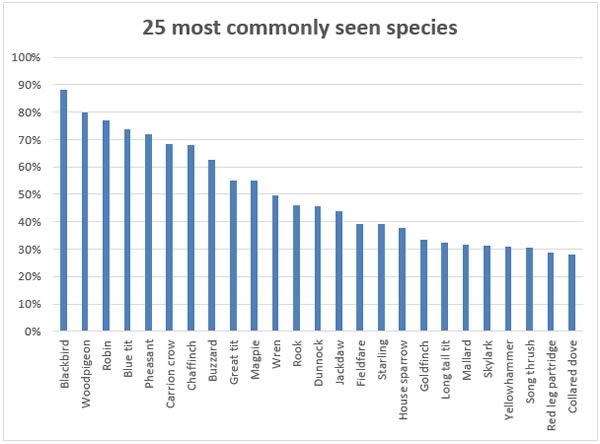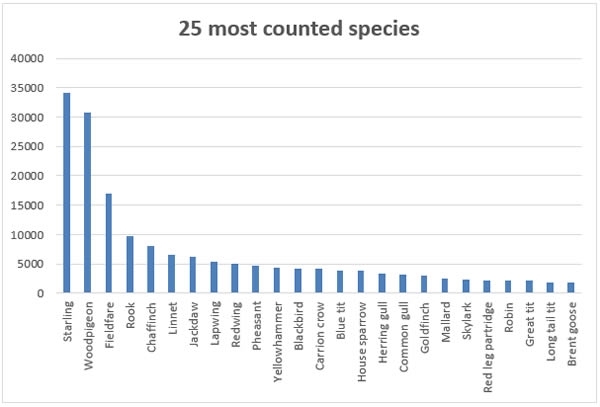February saw the fifth annual Big Farmland Bird Count (BFBC) organised by the Game & Wildlife Conservation Trust, and sponsored by BASF, with record numbers of participants and species recorded.
Over 1000 farmers took part and recorded 121 species across over 950,000 acres. That’s more farmers than in any previous year.
The BFBC was launched in 2014 to highlight the positive work done by farmers and gamekeepers in helping to reverse the decline in farmland bird numbers. The count offers a simple means of recording the effect of any conservation work currently being instigated by farmers and gamekeepers on their land, such as supplementary feeding birds through winter or growing crops specifically to provide seed for birds.
What did farmers see?
The most commonly seen species were blackbirds and woodpigeons, seen by over 80% of our participants. Robins, blue tits, and pheasants were seen by over 70% of the farmers.
The graph below shows the full list of the 25 most commonly seen species.

At the other end of the scale, we were delighted to see that a total of 25 species from the Red List for Birds of Conservation Concern were recorded, with 5 appearing in the 25 most commonly seen species list: fieldfares, starlings, house sparrows, song thrushes and yellowhammers. The most abundant of these were the first two, which were seen on nearly 40% of the farms taking part.
The five most abundant birds seen were starlings, woodpigeons, fieldfares, rooks and chaffinches. A total of 99,712 were found, making up nearly 50% of the total number of birds recorded.
It is interesting to note that this top five list is very similar to previous counts.
8 of the top 25 most abundant species are on the Red List for Birds of Conservation Concern: starlings, fieldfares, lapwings, linnets, redwings, herring gulls, yellowhammers, and house sparrows.

Who took part?
The type of farms taking part reflected the full range of farm businesses we had hoped to see.
The average farm size of those taking part was 1003 acres, with 69% growing arable crops, 52% having beef or sheep, and 12% growing field vegetables. There were also a number of dairy farms, horticulture units, poultry producers and pig producers submitting counts. We are really pleased to get such a variety of interest.
53% of participants are in some form of agri-environment scheme, demonstrating their long-term commitment to environmental management.
41% of participants were providing some form of extra seed feed for birds, either through growing wild bird seed mixes, or by providing additional grain through supplementary feeding either through scattering seed or providing it via hoppers.
Where were they from?
Farmers from every county in England took part and there were also responses from Northern Ireland, Scotland and Wales. We also had 32 farmers from Austria take part!
Suffolk had the most returns, with 67 farmers completing the survey. This was followed by Yorkshire with 63, Norfolk with 54, and Hampshire with 47. Our thanks go out to these counties for their huge support.
Where did they count?
The survey areas included important environmental features such as hedges, woodland ponds, grass margins, ditches and trees. Most survey took place on winter cereals, grassland or overwintered stubbles. The features recorded adjacent to the survey areas are a good demonstration of the variety of habitats present in farmland across the UK.

